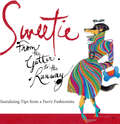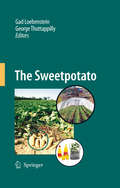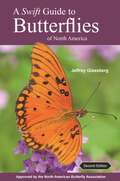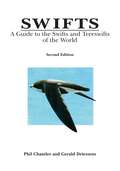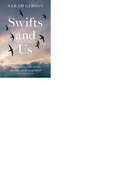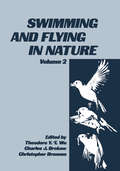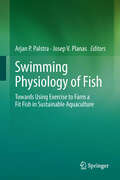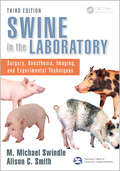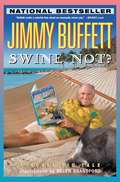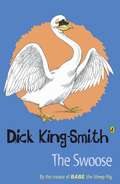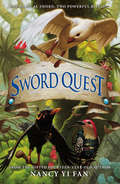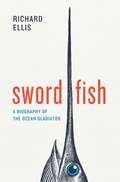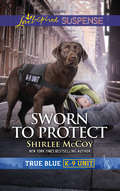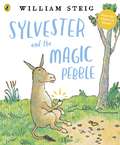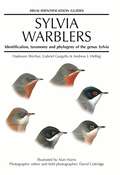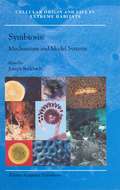- Table View
- List View
Sweet Sweet Revenge Ltd.: A Novel
by Jonas JonassonThe brand-new adventure from the beloved author of The Hundred Year-Old Man Who Climbed Out of the Window and Disappeared.
Sweetie: From the Gutter to the Runway Tantalizing Tips from a Furry Fashionista
by Mark Welsh Rubin ToledoSweetie established her biting wit and discerning taste on all things in fashion as the back page columnist for Elle magazine. Now, the self-appointed answer to every woman's prayers has compiled a book which tells readers about her rise from the gutter to the runway and offers advice, tips, and wry commentary on topics such as diet, exercise, art, hair, accessories, and travel. The book will be filled with four-color photos by Elle magazine's leading fashion photographers, illustrations by acclaimed fashion illustrator Ruben Toledo, and of course, Sweetie's incomparable wit. This is no ordinary self-help and beauty guide, especially when Sweetie's philosophy on dating and romance includes gems of advice like, "The best way to get over a man is to get under another one", and "Men will say anything to get into your kennel".
The Sweetpotato
by Gad Loebenstein George ThottappillyIn the last four decades of the twentieth century the use of sweetpotato was diversified beyond their classification as subsistence, food security, and famine-relief crop. In developing countries they serve both as human food and for feeding livestock. In Western countries they appeal to health conscious consumers because of their nutritional aspects. The sweetpotato is very high in nutritive value, and merits wider use on this account alone. The book has 2 parts. A general one giving up-to-date information on the history, botany, cultivars, genetic engineering, propagation, diseases and pests, nutritional data and marketing; and a second part presenting data on sweetpotato growing practices in different areas of the world. The information should be useful to researchers, practitioners and crop administrators in different countries.
A Swift Guide to Butterflies of Mexico and Central America: Second Edition
by Jeffrey GlassbergA groundbreaking photographic field guide to almost all of Mexico's butterfly species and many of Central America'sThis is a revised second edition of a groundbreaking photographic field guide to the butterflies of Mexico and Central America. Written by Jeffrey Glassberg, the pioneering authority on the field identification of butterflies, the guide covers more than 2,000 species and features over 3,700 large, gorgeous color photographs, the very best images available, accompanied by authoritative facing-page text. This second edition includes more species, more than 1,500 new photos, and updated text, maps, and species names. And range maps, field marks, and host plants are included for all Mexican butterflies. The result is an ideal field guide that will enable you to identify almost every butterfly you see.A revised second edition of a groundbreaking guide, featuring more species, more than 1,500 new photos, and updated text, maps, and species namesThe first complete guide to Mexican butterfliesCovers almost all of Mexico's more than 1,700 species, plus many Central American species, including more than two-thirds of those in Costa RicaWritten by the pioneering authority on the field identification of butterfliesBeautifully illustrated with more than 3,700 color photographs that highlight key identification featuresRange maps, field marks, and host plants for all Mexican speciesAuthoritative facing-page textAn invaluable tool for field identification
A Swift Guide to Butterflies of North America: Second Edition (PDF)
by Jeffrey GlassbergA thoroughly revised edition of the most comprehensive and authoritative photographic field guide to North American butterfliesThis is a revised second edition of the most detailed, comprehensive, and user-friendly photographic field guide to the butterflies of North America. Written by Jeffrey Glassberg, the pioneering authority on the field identification of butterflies, the guide covers all known species, beautifully illustrating them with 3,500 large, gorgeous color photographs—the very best images available. This second edition includes more than 500 new photos and updated text, maps, and species names. For most species, there are photographs of topsides and undersides, males and females, and variants. All text is embedded in the photographs, allowing swift access in the field, and arrows point to field marks, showing you exactly what to look for. Detailed, same-page range maps include information about the number of broods in each area and where strays have been recorded. Color text boxes highlight information about habitat, caterpillar food plants, abundance and flight period, and other interesting facts. Also included are a quick visual index and a caterpillar food plant index. The result is an ideal field guide that will enable you to identify almost every butterfly you see.A revised second edition of the most comprehensive photographic field guide to North American butterflies, featuring more than 500 new photos and updated text, maps, and species namesWritten by the pioneering authority on the field identification of butterfliesBeautifully illustrated with 3,500 color photographs that show all known species, including views of topsides and undersides, males and females, and variants for most speciesAuthoritative text embedded in the photographs for swift accessDetailed range mapsColor text boxes that highlight information about habitat, food plants, abundance and flight period, and other interesting factsAn invaluable tool for field identification
Swifts: A Guide to the Swifts and Treeswifts of the World (Helm Identification Guides)
by Phil Chantler Gerald DriessensThis work collates late-1990s research findings from the field of ornithology to provide a thoroughly modern overview of swift identification and distribution. This edition has revised artwork and maps, and much new textual material.
Swifts: A Guide to the Swifts and Treeswifts of the World (Helm Identification Guides)
by Phil Chantler Gerald DriessensThis work collates late-1990s research findings from the field of ornithology to provide a thoroughly modern overview of swift identification and distribution. This edition has revised artwork and maps, and much new textual material.
Swifts and Us: The Life Of The Bird That Sleeps In The Sky
by Sarah GibsonSwifts live almost entirely in the air. They eat, drink, sleep, mate and gather their nesting materials on the wing, fly thousands of miles across the world, navigating their way around storms, never lighting on tree, cliff or ground, until they return home with the summer.
Swimming Against the Storm
by Jess ButterworthHeartland middle-grade adventure set in the swamps of Louisiana, perfect for fans of Katherine Rundell and Lauren St JohnOur land is sinking. It's disappearing into the water. And no one knows how to save it.Twelve-year-old Eliza and her sister Avery have lived their entire lives in a small fishing village on the coast of Louisiana, growing up alongside turtles, pelicans and porpoises. But now, with sea levels rising, their home is at risk of being swept away.Determined to save the land, Eliza and her younger sister Avery secretly go searching in the swamp for the dangerous, wolf-like loup-garou. If they can prove this legendary creature exists, they're sure that the government will have to protect its habitat - and their community.But there's one problem: the loup-garou has never been seen before. And with a tropical storm approaching and the sisters deep, deep in the swampland, soon it's not just their home at risk, but their lives as well...
Swimming and Flying in Nature: Volume 2
by Theodore WuThe Symposium on Swimming and Flying in Nature which was held at the California Institute of Technology, Pasadena, California from July 8-12, 1974 was conceived with the objective of providing an interdisciplinary forum for the discussion of funda mental biological and fluid mechanical aspects of these forms of natura110comotion. It was the earnest hope of all concerned in the organization of the Symposium that the exchange of knowledge and interaction of ideas from the disciplines involved would stimu late new research in this developing field. If the liveliness of the discussion generated among the 250 or so participants is any measure, then this objective was fulfilled to a significant degree. These two companion volumes contain the manuscripts of the papers presented during the Symposium. It is hoped that this permanent record will serve to perpetuate the enthusiasm and active thought generated during those days in Pasadena. The first volume contains the proceedings of the first two days of the confer ence (Sessions I to IV) which concentrated on the locomotion of micro-organisms. The second volume (Sessions V to VIII) deals with the propulsion of larger fish, insects and birds. Professor Sir James Lighthill's Special Invited Lecture which opened the Symposium is contained in the second volume, rather than the first, since it deals with natural flight.
Swimming Physiology of Fish: Towards Using Exercise to Farm a Fit Fish in Sustainable Aquaculture
by Arjan P. Palstra and Josep V. PlanasIn light of mounting fishing pressures, increased aquaculture production and a growing concern for fish well-being, improved knowledge on the swimming physiology of fish and its application to fisheries science and aquaculture is needed. This book presents recent investigations into some of the most extreme examples of swimming migrations in salmons, eels and tunas, integrating knowledge on their performance in the laboratory with that in their natural environment. For the first time, the application of swimming in aquaculture is explored by assessing the potential impacts and beneficial effects. The modified nutritional requirements of “athletic” fish are reviewed as well as the effects of exercise on muscle composition and meat quality using state-of-the-art techniques in genomics and proteomics. The last chapters introduce zebrafish as a novel exercise model and present the latest technologies for studying fish swimming and aquaculture applications.
Swine in the Laboratory: Surgery, Anesthesia, Imaging, and Experimental Techniques, Third Edition
by M. Michael Swindle Alison C. SmithFor two decades, Swine in the Laboratory: Surgery, Anesthesia, and Experimental Techniques has been the most respected practical technical guide for medical and veterinary researchers using swine as experimental animals. Extensively updated and expanded since the publication of the second edition in 2007 and now sponsored by the American College of
Swine Not?: A Novel
by Jimmy BuffettBestselling writer Jimmy Buffett weaves an irresistible tale filled with colorful characters, wry humor, and the pursuit of a very clever pig. When Southern belle Ellie McBride moves her twins from Vertigo, to New York City, they wouldn't dream of leaving behind the family pig Rumpy. But the posh hotel where Ellie has found work (and living space) has "No Pets" writ large on its portal. So hiding Rumpy from the hotel staff -- -especially the ultra-carnivorous hotel chef, who would like nothing better than to transform their pet into pork roast -- -becomes imperative.
Swing, Sloth!: Level 1 (National Geographic Readers Ser.)
by Susan B. Neuman National Geographic Kids StaffNational Geographic Primary Readers pair magnificent National Geographic photographs with engaging text by skilled authors to help your child learn to read. Developed by education experts, this series of books for beginner readers is spread across four levels: Early Reader, Becoming Fluent, Becoming Independent and Independent Reader. Come along on an adventure through the rain forest! Along the way, you'll meet new friends big and small, see amazing sights, and learn all about the creatures that make their home in the rain forest. Told in simple yet lively text, Swing, Sloth! will enchant children who are just beginning their reading journey. Level 1: Early Reader books contain simple sentences and are just right for kids who can decode with ease and are beginning to read fluently. They are ideal for readers of Yellow and Blue book bands for guided reading.
The Swoose
by Dick King-SmithFitzherbert's mother is a goose, but his father was a swan - which makes him a swoose! As Fitzherbert grows up he decisdes he wants to fly and he wants to meet his father. His search begins, but what he finds is fame and fortune of a most unexpected kind.
Sword Quest (Swordbird Ser. #2)
by Nancy Yi FanThe Prequel to Swordbird – another epic fantasy from fourteen-year-old child prodigy Nancy Yi Fan, with beautiful illustrations by Mark Zug. Sworquest will be published globally by HarperCollins. An exciting and action-packed tale of birds at war, this novel shows how friendship and courage can overcome tyranny.
Swordfish: A Biography of the Ocean Gladiator
by Richard EllisA perfect fish in the evolutionary sense, the broadbill swordfish derives its name from its distinctive bill—much longer and wider than the bill of any other billfish—which is flattened into the sword we all recognize. And though the majesty and allure of this warrior fish has commanded much attention—from adventurous sportfishers eager to land one to ravenous diners eager to taste one—no one has yet been bold enough to truly take on the swordfish as a biographer. Who better to do so than Richard Ellis, a master of marine natural history? Swordfish: A Biography of the Ocean Gladiator is his masterly ode to this mighty fighter. The swordfish, whose scientific name means “gladiator,” can take on anyone and anything, including ships, boats, sharks, submarines, divers, and whales, and in this book Ellis regales us with tales of its vitality and strength. Ellis makes it easy to understand why it has inspired so many to take up the challenge of epic sportfishing battles as well as the longline fishing expeditions recounted by writers such as Linda Greenlaw and Sebastian Junger. Ellis shows us how the bill is used for defense—contrary to popular opinion it is not used to spear prey, but to slash and debilitate, like a skillful saber fencer. Swordfish, he explains, hunt at the surface as well as thousands of feet down in the depths, and like tuna and some sharks, have an unusual circulatory system that gives them a significant advantage over their prey, no matter the depth in which they hunt. Their adaptability enables them to swim in waters the world over—tropical, temperate, and sometimes cold—and the largest ever caught on rod and reel was landed in Chile in 1953, weighing in at 1,182 pounds (and this heavyweight fighter, like all the largest swordfish, was a female). Ellis’s detailed and fascinating, fact-filled biography takes us behind the swordfish’s huge, cornflower-blue eyes and provides a complete history of the fish from prehistoric fossils to its present-day endangerment, as our taste for swordfish has had a drastic effect on their population the world over. Throughout, the book is graced with many of Ellis’s own drawings and paintings, which capture the allure of the fish and bring its splendor and power to life for armchair fishermen and landlocked readers alike.
Swordfish: A Biography of the Ocean Gladiator
by Richard EllisA perfect fish in the evolutionary sense, the broadbill swordfish derives its name from its distinctive bill—much longer and wider than the bill of any other billfish—which is flattened into the sword we all recognize. And though the majesty and allure of this warrior fish has commanded much attention—from adventurous sportfishers eager to land one to ravenous diners eager to taste one—no one has yet been bold enough to truly take on the swordfish as a biographer. Who better to do so than Richard Ellis, a master of marine natural history? Swordfish: A Biography of the Ocean Gladiator is his masterly ode to this mighty fighter. The swordfish, whose scientific name means “gladiator,” can take on anyone and anything, including ships, boats, sharks, submarines, divers, and whales, and in this book Ellis regales us with tales of its vitality and strength. Ellis makes it easy to understand why it has inspired so many to take up the challenge of epic sportfishing battles as well as the longline fishing expeditions recounted by writers such as Linda Greenlaw and Sebastian Junger. Ellis shows us how the bill is used for defense—contrary to popular opinion it is not used to spear prey, but to slash and debilitate, like a skillful saber fencer. Swordfish, he explains, hunt at the surface as well as thousands of feet down in the depths, and like tuna and some sharks, have an unusual circulatory system that gives them a significant advantage over their prey, no matter the depth in which they hunt. Their adaptability enables them to swim in waters the world over—tropical, temperate, and sometimes cold—and the largest ever caught on rod and reel was landed in Chile in 1953, weighing in at 1,182 pounds (and this heavyweight fighter, like all the largest swordfish, was a female). Ellis’s detailed and fascinating, fact-filled biography takes us behind the swordfish’s huge, cornflower-blue eyes and provides a complete history of the fish from prehistoric fossils to its present-day endangerment, as our taste for swordfish has had a drastic effect on their population the world over. Throughout, the book is graced with many of Ellis’s own drawings and paintings, which capture the allure of the fish and bring its splendor and power to life for armchair fishermen and landlocked readers alike.
Swordfish: A Biography of the Ocean Gladiator
by Richard EllisA perfect fish in the evolutionary sense, the broadbill swordfish derives its name from its distinctive bill—much longer and wider than the bill of any other billfish—which is flattened into the sword we all recognize. And though the majesty and allure of this warrior fish has commanded much attention—from adventurous sportfishers eager to land one to ravenous diners eager to taste one—no one has yet been bold enough to truly take on the swordfish as a biographer. Who better to do so than Richard Ellis, a master of marine natural history? Swordfish: A Biography of the Ocean Gladiator is his masterly ode to this mighty fighter. The swordfish, whose scientific name means “gladiator,” can take on anyone and anything, including ships, boats, sharks, submarines, divers, and whales, and in this book Ellis regales us with tales of its vitality and strength. Ellis makes it easy to understand why it has inspired so many to take up the challenge of epic sportfishing battles as well as the longline fishing expeditions recounted by writers such as Linda Greenlaw and Sebastian Junger. Ellis shows us how the bill is used for defense—contrary to popular opinion it is not used to spear prey, but to slash and debilitate, like a skillful saber fencer. Swordfish, he explains, hunt at the surface as well as thousands of feet down in the depths, and like tuna and some sharks, have an unusual circulatory system that gives them a significant advantage over their prey, no matter the depth in which they hunt. Their adaptability enables them to swim in waters the world over—tropical, temperate, and sometimes cold—and the largest ever caught on rod and reel was landed in Chile in 1953, weighing in at 1,182 pounds (and this heavyweight fighter, like all the largest swordfish, was a female). Ellis’s detailed and fascinating, fact-filled biography takes us behind the swordfish’s huge, cornflower-blue eyes and provides a complete history of the fish from prehistoric fossils to its present-day endangerment, as our taste for swordfish has had a drastic effect on their population the world over. Throughout, the book is graced with many of Ellis’s own drawings and paintings, which capture the allure of the fish and bring its splendor and power to life for armchair fishermen and landlocked readers alike.
Swordfish: A Biography of the Ocean Gladiator
by Richard EllisA perfect fish in the evolutionary sense, the broadbill swordfish derives its name from its distinctive bill—much longer and wider than the bill of any other billfish—which is flattened into the sword we all recognize. And though the majesty and allure of this warrior fish has commanded much attention—from adventurous sportfishers eager to land one to ravenous diners eager to taste one—no one has yet been bold enough to truly take on the swordfish as a biographer. Who better to do so than Richard Ellis, a master of marine natural history? Swordfish: A Biography of the Ocean Gladiator is his masterly ode to this mighty fighter. The swordfish, whose scientific name means “gladiator,” can take on anyone and anything, including ships, boats, sharks, submarines, divers, and whales, and in this book Ellis regales us with tales of its vitality and strength. Ellis makes it easy to understand why it has inspired so many to take up the challenge of epic sportfishing battles as well as the longline fishing expeditions recounted by writers such as Linda Greenlaw and Sebastian Junger. Ellis shows us how the bill is used for defense—contrary to popular opinion it is not used to spear prey, but to slash and debilitate, like a skillful saber fencer. Swordfish, he explains, hunt at the surface as well as thousands of feet down in the depths, and like tuna and some sharks, have an unusual circulatory system that gives them a significant advantage over their prey, no matter the depth in which they hunt. Their adaptability enables them to swim in waters the world over—tropical, temperate, and sometimes cold—and the largest ever caught on rod and reel was landed in Chile in 1953, weighing in at 1,182 pounds (and this heavyweight fighter, like all the largest swordfish, was a female). Ellis’s detailed and fascinating, fact-filled biography takes us behind the swordfish’s huge, cornflower-blue eyes and provides a complete history of the fish from prehistoric fossils to its present-day endangerment, as our taste for swordfish has had a drastic effect on their population the world over. Throughout, the book is graced with many of Ellis’s own drawings and paintings, which capture the allure of the fish and bring its splendor and power to life for armchair fishermen and landlocked readers alike.
Sylvanian Families: An Official Sylvanian Families Story
by Macmillan Children's BooksCome and celebrate Freya the Chocolate Rabbit's birthday with all her friends in the Sylvanian Village in this sweet picture book, based on the animation Freya's Happy Diary, now showing on YouTube!It's Freya's birthday and she's having a party, but her best friends, Ralph Walnut and Lyra Persian, are nowhere to be found! As Freya searches, she meets lots of friends and neighbours who give her presents of shiny, bright balloons. So many balloons, in fact, that she's lifted right into the air!As she soars over the Sylvanian Village, she starts to wonder how she will ever get down . . . and whether her two best friends will turn up in time to help.This adorable picture book features artwork from the animated Sylvanian Families series, Freya's Happy Diary, and brings the classic and beloved toy range to life as never before.Also available: The World of Sylvanian Families: The Official Guide, Easter Search-and-Find and more!
Sylvester and the Magic Pebble (Stories To Go! Ser.)
by William SteigOne rainy day, Sylvester finds a magic pebble that can make all his wishes come true. But when a lion frightens him on his way home, Sylvester makes a wish with unexpected consequences. Will Sylvester find his way back to his family? Winner of the 1970 Caldecott Medal, this modern classic is full of warmth, humour and joy.
Sylvia Warblers: Identification, taxonomy and phylogeny of the genus Sylvia (Helm Identification Guides)
by Andreas Helbig Gabriel Gargallo Hadoram ShirihaiBased on phylogenetic research, this complete study of the genus Sylvia describes two new species and establishes identification criteria for all members of the family.A lengthy introduction explains the background to the research and outlines the main features of the genus. The 25 species are then treated in detail, including the African parisomas, which are here included in the Sylva group. The species accounts include sections on every aspect of identification, with colour illustrations showing age, sex and racial differences, distribution maps, sonograms, moult and wing diagrams and tables."
Symbiosis: Mechanisms and Model Systems (Cellular Origin, Life in Extreme Habitats and Astrobiology #4)
by Joseph SeckbachSymbiosis is the fourth volume in the series Cellular Origin and Life in Extreme Habitats (COLE). Fifty experts, from over a dozen countries, review their current studies on different approaches to these phenomena. The chapters present various aspects of symbiosis from gene transfer, morphological features, and biodiversity to individual organisms sharing mutual cellular habitats. The origin of the eukaryotic phase is discussed with emphasis on cyanelles, H syntrophy, N2 fixation, and S-based symbiosis (as well as the origin of mitochondrion, chloroplast, and nucleus). All members of the three domains of life are presented for sharing symbiotic associations. This volume brings the concept of living together as `One plus One (plus One) equals One.' The purpose of this book is to introduce the teacher, researcher, scholar, and student as well as the open-minded and science-oriented reader to the global importance of this association.

